Matteo Garrone: Bigger than life
by Mark Reynolds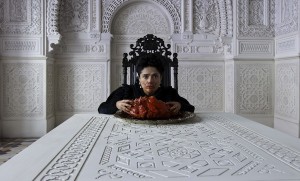 Tale of Tales. Curzon Artificial Eye” width=”360″ height=”217″>Matteo Garrone’s latest film, Tale of Tales, is a flamboyantly grisly retelling of three little-known fairy tales collected in the seventeenth century by Neapolitan poet and courtier Giambattista Basile. From the 50 tales in the collection, which includes the earliest – and bawdiest – recorded versions of Cinderella, Sleeping Beauty and Hansel and Gretel, the director picks out stories about three women at different ages, linked by themes of passion, pride, yearning and obsession.
Tale of Tales. Curzon Artificial Eye” width=”360″ height=”217″>Matteo Garrone’s latest film, Tale of Tales, is a flamboyantly grisly retelling of three little-known fairy tales collected in the seventeenth century by Neapolitan poet and courtier Giambattista Basile. From the 50 tales in the collection, which includes the earliest – and bawdiest – recorded versions of Cinderella, Sleeping Beauty and Hansel and Gretel, the director picks out stories about three women at different ages, linked by themes of passion, pride, yearning and obsession.
Seemingly a remove from the director’s recent contemporary dramas Gomorrah and Reality, in fact a common thread of grotesque humanity can be seen across his work. Tale of Tales combines glorious locations, eye-popping puppetry and dazzling special effects in an assault on the senses that can be baffling on first viewing: what could possibly link an underwater battle with a sea monster, an old woman who begs to be flayed in a bid to recapture her youth, a king’s lust and an ogre’s sorrowful pursuit of love and tolerance?
This is glorious gothic horror, told with a comic touch yet firmly rooted in humanity’s darkest desires. In a striking departure from the director’s usual approach of working with relative unknowns, a starry international cast includes Salma Hayek, Vincent Cassell, John C. Reilly, Shirley Henderson, Hayley Carmichael and Toby Jones, all of whom dive into their roles with joyful abandon. I chat to Garrone about his discovery of the source text and his future plans.
MR: First of all, thanks so much for introducing me to Basile. I’d not come across him before, and right after the screening I got hold of the new Penguin edition and I’m absolutely loving it.
MG: Yes, it’s an incredible book, it’s a masterpiece of literature, and it’s also quite unknown in Italy. I discovered the book quite late, from the suggestion of a painter friend – I was a painter before I became a director – I first read the book five or six years ago.
I’m very happy that the movie helps give the stories the attention they deserve, to create curiosity to go to the source, because there are so many beautiful tales.”
Oh, I’d imagined you’d grown up with it. Is that something that only Neapolitans do?
Even in Naples they don’t know it very well. It’s a very important book because it inspired all the greatest writers of fairy tales: the Brothers Grimm, Perrault, Andersen, but while in time the Brothers Grimm and the others became very famous, Basile remained in the shadows.
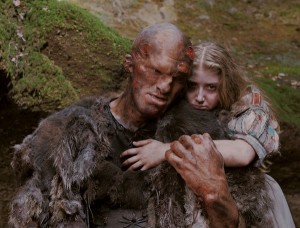 Tale of Tales. Curzon Artificial Eye” width=”320″ height=”244″>So are you leading a revival?
Tale of Tales. Curzon Artificial Eye” width=”320″ height=”244″>So are you leading a revival?
Yes, I’m very happy that the movie helps give the stories the attention they deserve, to create curiosity like happened to you to go to the source, because there are so many beautiful tales.
Any prospect of a Tale of Tales 2?
I don’t know. At one point I wanted to make a second, with three more stories. Here the movie is doing well, but it was not so well received in other countries. Maybe for reasons connected to the choice to make it in English with stars. For some countries, like France, it looks like I made a compromise with the market. They were really against it.
Since we’ve all been ruled by kings and queens who don’t even speak our language, it’s fun to have all the different accents in the mix. Plus it adds to the fairy tale element to have more exotic voices.
There is also something Shakespearean in Basile. Italo Calvino used to say that the tales of Basile are like the dreams of a “deformed Neapolitan Shakespeare” or something like that. He made the connection between Basile and Shakespeare, who were writing in the same period. So I thought I could use English without betraying Basile. And anyway the dialogue in Basile is just ten per cent of it. The beautiful part of the tales is the description, the atmosphere, the proverbs. So when you make an adaptation and you decide to make it in English it’s an important choice, but not one that changes the soul of the stories.
Do you consider this film to be a departure from your other work?
Not at all. In all my movies there is a fairy tale component. In this case I start from the supernatural and bring these tales into a realistic dimension. In my other movies I made the opposite journey.
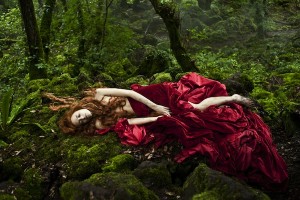 Tale of Tales. Curzon Artificial Eye” width=”320″ height=”213″>How long, and how complicated was the shoot?
Tale of Tales. Curzon Artificial Eye” width=”320″ height=”213″>How long, and how complicated was the shoot?
We shot for three and a half months. It was a long journey, and we travelled from Sicily to Apulia, then from Apulia to Lazio, and from Lazio to Tuscany. The only problem that was quite frustrating was the work with special effects. I always want to control the visual aspect of a movie, and sometimes when you work with special effects you have to trust in what you will see after. It’s like if you are a painter and you paint a part of the canvas and then you have to give it to someone else to fill in the rest.
With the puppets you were very particular about capturing as much movement as possible on film. Not so much was added digitally afterwards.
No, we wanted to have special effects made on reel, made on the set, then use digital just as integration. But we wanted to make a movie that was also a sort of homage to the beginning of cinema, to silent movies. The scene fighting the sea monster under the sea is like an old movie of Méliès. We also wanted to give the feeling of a theatrical approach, where you feel the construction. Rather than hide the artificial aspect of cinema, we wanted to highlight it. But at the same time we wanted to create images that could be believable for the audience. In this sense I think it’s very different from Gomorrah, the language is completely different, because in Gomorrah I wanted to hide all the artificiality, and give the audience the feeling of an insider documentary.
Basile wrote the stories thinking it was just for entertainment. And not for kids, because in the seventeenth century there was no literature for kids.”
You dedicate the film to your father Nico and your former DP Marco Onorato…
My two fathers. My father split with my mother when I was two or three years old, and then my mother was Marco’s companion for forty years. Marco was the director of photography for all my movies, and also the father of my brother. So he was my second father. My father helped me a lot. He was a theatre critic and also the director of a cultural programme, so he helped my approach in art. A lot of actors that act in my movies before Tale of Tales, but also in Tale of Tales, for instance the magician, are Italian actors that I saw in theatre with my father. So I dedicated it to my father, and to Marco because it’s the first movie that I’ve made without him.
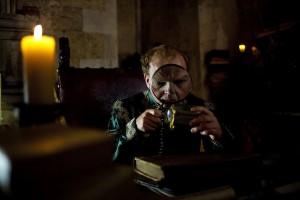 Tale of Tales. Curzon Artificial Eye” width=”320″ height=”213″>The translation I’m reading really captures the timelessness and striking modernity of the stories. And they are definitely tales for adults.
Tale of Tales. Curzon Artificial Eye” width=”320″ height=”213″>The translation I’m reading really captures the timelessness and striking modernity of the stories. And they are definitely tales for adults.
Yes, it’s very modern. The tales were written by Basile for entertainment at court. The first edition was published by Basile’s sister, who was a very famous singer, after her brother died. Basile wrote the stories thinking it was just for entertainment. And not for kids, because in the seventeenth century there was no literature for kids. So he wrote for pleasure, not thinking that it would become a massive piece of Italian literature.
But also to capture an oral storytelling tradition.
Yes, the horror stories from below, from poor people. He used to live in the court, but go down to find these stories among the people. The basis of these stories is medieval, that’s why they are so dark, full of violence and horror.
So which other Italian classics have been neglected and should we be reading?
When I find them, I’ll make another movie!
Do you have any other adaptations in the pipeline?
Yes, next I’m planning to make an adaptation of the most famous Italian book: I’m working on an adaptation of Pinocchio.
Fantastic. I read a new translation of the original Pinocchio quite recently, and it’s very different from the version most people know.
Of course, it’s very dark. The sense of death, it’s like Edgar Allan Poe, it’s like Hoffmann. That’s why I want to make it. It will probably be in Italian this time. It will be difficult because the material’s not virgin to the audience this time, and the special effects will have to be precise, but I want to use the many lessons I learned making Tale of Tales. I’m very excited. It’s strange, but the only way to be original is to be faithful to the book. Other adaptations have tried to be original or inventive, and they failed. I just want to be faithful to the soul of the book.
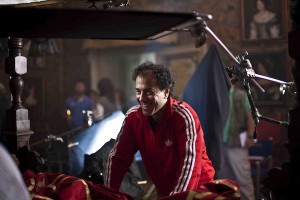 Tale of Tales. Curzon Artificial Eye” width=”290″ height=”193″>Matteo Garrone was born in Rome in 1968. He is best known for Gomorrah (2008) and Reality (2012), both winners of the Grand Prix du Jury at Cannes. His other films include The Embalmer (2002) and First Love (2005). Tale of Tales is in cinemas and on demand from Friday 17 June.
Tale of Tales. Curzon Artificial Eye” width=”290″ height=”193″>Matteo Garrone was born in Rome in 1968. He is best known for Gomorrah (2008) and Reality (2012), both winners of the Grand Prix du Jury at Cannes. His other films include The Embalmer (2002) and First Love (2005). Tale of Tales is in cinemas and on demand from Friday 17 June.
taleoftalesfilm.com
Mark Reynolds is a freelance editor and writer and a founding editor of Bookanista.
@bookanista
Film images courtesy Curzon Artificial Eye
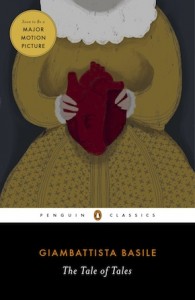 A new edition of Giambattista Basile’s The Tale of Tales, translated and with notes by Nancy L. Canepa, and with an introduction by Jack Zipes, is published by Penguin Classics.
A new edition of Giambattista Basile’s The Tale of Tales, translated and with notes by Nancy L. Canepa, and with an introduction by Jack Zipes, is published by Penguin Classics.
Read more.

